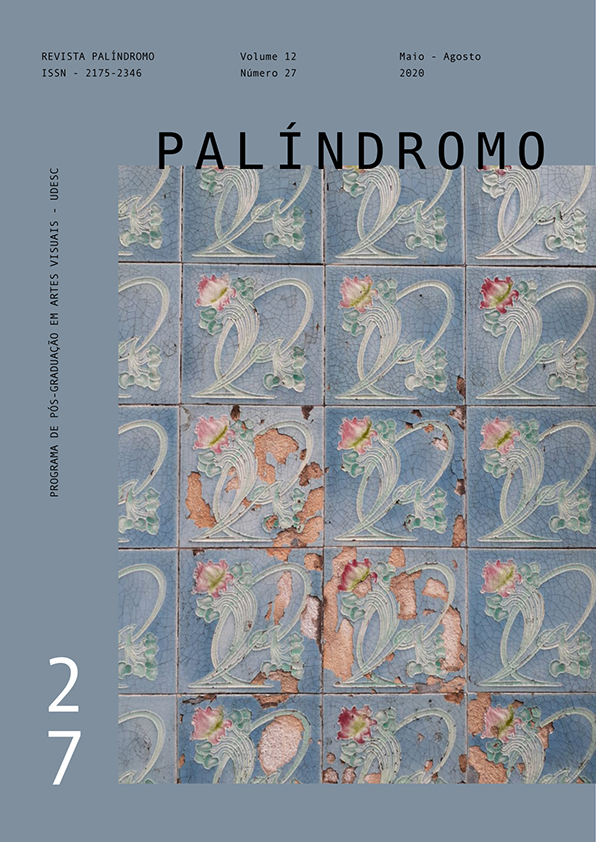A imagem-ficção como estratégia de ação para mundos possíveis
DOI:
https://doi.org/10.5965/2175234612272020199Palavras-chave:
mundos possíveis, imagem-ficção, fingere, arte contemporânea, teoria da imagemResumo
Neste artigo, propõe-se uma aplicação das teorias dos mundos possíveis no estudo da imagem e de seus efeitos. Após uma breve introdução a esse universo teórico, passa-se para o contexto das artes visuais, no qual não existem ainda muitos trabalhos publicados a respeito. Desenvolve-se um pensamento dos modos de fazer mundos, que emerge de uma imagem-ficção ativa, instaurada pelo fingere. A atitude de autodenunciação dessa imagem permite ao espectador encontrar evidências de sua qualidade de manipulada, o que acaba por permitir uma mudança cognitiva em relação às construções e mudanças que podemos realizar no nosso mundo dito real. Após um estudo de caso, conclui-se que, como a imagem, a realidade é matéria manipulável, e a compreensão disso abre vias para a construção de novos contextos na atualidade.
Downloads
Referências
BOILLAT, A. Cinéma, machine à mondes: essai sur les films à univers multiples. Chê-ne-Bourg: Georg, 2014.
CARVALHO, J. D. Artes e mundos possíveis. Aisthe, v. 6, n. 10, p. 120–137, 12 out. 2012.
DOLEŽEL, L. Heterocosmica: Fiction and Possible Worlds. Baltimore: Johns Hopkins Universi-ty Press, 1998.
DUBOIS, P. De l’image-trace à l’image-fiction. Le mouvement des théories de la pho-tographie de 1980 à nos jours. Études photographiques, n. 34, 4 jun. 2016.
FROGIER, L.; Parc de la Villette. Li Wei. Arles/Paris: Actes Sud, Parc de la Villette, 2012. Catálogo de exposição, 20 mars-19 août 2012.
GOODMAN, N. Manières de faire des mondes. Paris: Gallimard, 2006.
GUELTON, B. Archifiction: quelques rapports entre les arts visuels et la fiction. Paris: Publications de la Sorbonne, 2007.
KRIPKE, S. Semantical considerations on Modal Logic. In: LINSKY, Leonard (Ed.). Re-ference and Modality. Oxford: Oxford University Press, 1979, p. 63–72.
KRIPKE, S. La logique des noms propres. Paris: Éd. de Minuit, 1982.
LAVOCAT, F. Fait et fiction: pour une frontière. Paris: Seuil, 2016.
LAVOCAT, F. (Org.). La théorie littéraire des mondes possibles. Paris: CNRS, 2010.
LEIBNIZ, G. W. Essais de théodicée: sur la bonté de Dieu, la liberté de l’homme et l’origine du mal. Paris: Flammarion, 1969.
LINDE, U. Image and Dimension. In: ALLÉN, S. (Org.). Possible Worlds in Humanities, Arts and Sciences: Proceedings of Nobel Symposium 65. Berlin; New York: De Gruyter, 1989, p. 312–318.
OWENS, C. Beyond Recognition: Representation, Power, and Culture. Berkeley: Uni-versity of California Press, 1992.
PAVEL, T. Possible Worlds in Literary Semantics. The Journal of Aesthetics and Art Criticism, v. 34, n. 2, p. 165–176, 1975.
PAVEL, T. Univers de la fiction. Paris: Seuil, 1988.
RYAN, M.-L. Possible Worlds, Artificial Intelligence, and Narrative Theory. Blooming-ton: Indiana University Press, 1991.SCHAEFFER, J.-M. Pourquoi la fiction? Paris: Seuil, 1999.
SCHMUTZ, J. Qui a inventé les mondes possibles? In: BARDOUT, Jean-Christophe; JULLIEN, Vincent (Eds.). Les mondes possibles. Cahiers de philosophie de l’Université de Caen. Caen: Presses Univ. de Caen, 2006, p. 9–38.
SOURIAU, É. La correspondance des arts: éléments d’esthétique comparée. Paris: Flammarion, 1969.
Downloads
Publicado
Como Citar
Edição
Seção
Licença
Copyright (c) 2020 Palíndromo

Este trabalho está licenciado sob uma licença Creative Commons Attribution 4.0 International License.
DECLARAÇÃO DE DIREITOS AUTORAIS
a. Os artigos publicados pela revista são de uso gratuito, destinados a aplicações acadêmicas e não comerciais. Todos os direitos autorais são atribuídos à revista. Os artigos cujos autores são identificados representam a expressão do ponto de vista de seus autores e não a posição oficial da Revista Palíndromo. O (s) autor (es) compromete-se sempre que publicar material referente ao artigo publicado no Palíndromo mencionar esta publicação da seguinte forma:
Este artigo foi publicado originalmente pela revista Palíndromo em seu volume (coloque o volume), número (coloque o número) no ano de (coloque o ano) e pode ser acessado em: http://www.revistas.udesc.br/index.php/palindromo
b. Plágio, em todas as suas formas, constitui um comportamento antiético de publicação e é inaceitável. A revista Palíndromo utiliza o software iThenticate de controle de similaridade


